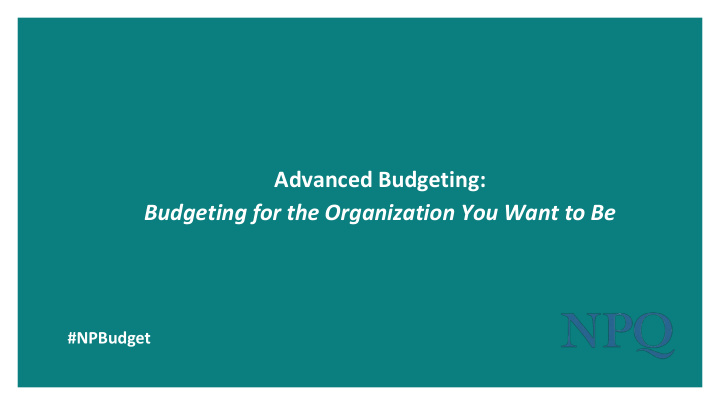



Advanced Budgeting: Budgeting for the Organization You Want to Be #NPBudget
Welcome, Leading Edge Members! February Kim Klein on building a thriving major donor program March Paul Sussman on whether and how to have an endowment April Gina McDonald on the realities of FASB’s liquidity disclosure May Vernetta Walker & Marla Cornelius on true board engagement
About our Guest Faculty Kate Barr President, Propel Nonprofits
4 elements of a budget that drive its quality The process to develop it, including 1. who is involved Its content 2. Its format 3. How it’s operationalized 4. If you want a different result, adjust the levers above.
Unpacking budget development A Setting priorities/parameters B Providing the raw input C Sensemaking of the raw input’s themes/tensions D Grappling and decision-making Always know where you are in the process and who needs to be E Finalizing for presentation involved. F Vetting carefully Understanding and approving G H Assessing process and improving for next time
“Advanced budgeting” is really the process of moving from a generic approach to an approach specific to the organization you want to be.
Valuing the time and effort of all the work ▹ Supervision and mentoring ▹ Professional development ▹ Research and development ▹ Collaboration ▹ Advocacy ▹ Evaluation and learning ▹ Diversity, equity, and inclusion work TIP: Reflect on your time-tracking system. How does it interface with your budgeting approach?
Capturing one-time and periodic investments ▹ Strategy and change management efforts ▹ Rebranding ▹ Data/technology ▹ Building organizational infrastructure
Use columns to lift out change work/capital deployment Annual Budget 2020 Operating Change Capital Total Income Grants $ 1,250,000 $ 100,000 $ 1,350,000 Fees $ 345,000 $ - $ 345,000 This year, we have Total $ 1,595,000 $ 100,000 $ 1,695,000 $100,000 from the XYZ Foundation to do Expenses intensive equity and Compensation $ 875,000 $ 40,000 $ 915,000 inclusion work. Consultants $ - $ 40,000 $ 40,000 Supplies $ 55,000 $ 20,000 $ 75,000 Occupancy $ 300,000 $ 300,000 Other $ 200,000 $ 200,000 Total $ 1,430,000 $ 100,000 $ 1,530,000 Net $ 165,000 $ - $ 165,000
Budgeting in times of change Consider scenario budgeting when: ▻ The uncertainty is high ▻ Trying something new ▻ Planning for potential loss of income ▻ Grant or contract uncertainty ▻ Potential merger/collaboration ▻ Potential for significant growth
Use columns to lift out multiple scenarios Annual Budget 2020 Conservative Growth Total Income We hope to open a Grants $ 1,250,000 $ 400,000 $ 1,650,000 second location Fees $ 345,000 $ 100,000 $ 445,000 pending a $400,000 Total $ 1,595,000 $ 500,000 $ 2,095,000 grant from XYZ Foundation. Our fee Expenses income would also go Compensation $ 875,000 $ 300,000 $ 1,175,000 Consultants $ - $ 75,000 $ 75,000 up with service to Supplies $ 55,000 $ 20,000 $ 75,000 more clients. Occupancy $ 300,000 $ 100,000 $ 400,000 Other $ 200,000 $ 200,000 Total $ 1,430,000 $ 495,000 $ 1,925,000 Net $ 165,000 $ 5,000 $ 170,000
Budgeting to build reserves/self-investment capital All nonprofits need money in savings to weather cash flow challenges and unexpected shortfalls. We also need resources to invest in our own growth and improvement. These are only possible with annual surpluses that are retained for future use.
Options for communicating surpluses Annual Budget 2020 Annual Budget 2020 Income Income Grants $ 1,250,000 Grants $ 1,250,000 Fees $ 345,000 Fees $ 345,000 Total $ 1,595,000 Total $ 1,595,000 Expenses Expenses Compensation $ 875,000 Compensation $ 875,000 Consultants $ - Consultants $ - Supplies $ 55,000 Supplies $ 55,000 Occupancy $ 300,000 Occupancy $ 300,000 Other $ 200,000 Other $ 200,000 Total $ 1,430,000 Board-designated reserve* $ 165,000 Total $ 1,595,000 Net* (see note) $ 165,000 Net $ - *Note: By policy of our board of directors, we maintain a 6-month, *Note: By policy of our board of directors, we maintain a 6-month, board- board-designated reserve. Modest designated reserve. Maintenance requires regular contributions. annual surpluses maintain that balance.
Budgeting inside a strategic planning process ▻ More projection than budgeting ▻ Multi-year like the plan is ▻ Requires careful analysis of internal and external factors ▻ Factors in the sequencing of capacity and strategies ▻ Makes visible the required investments to achieve strategies
Budgeting for and during a CEO transition ▹ Ensure your board is up to speed ▹ Squirrel away some cash ▹ Discern if it will in fact be a down fundraising year ▹ Search and onboarding costs, including the possibility of higher compensation ▹ Assess: Will there be ripple effects, including other staff departures? ▹ Be very clear on financial assumptions to watch together
▻ Compensation (salary and benefits)—articulate a philosophy ▻ Workloads and workplace culture Centering ▻ Who is in leadership? Who manages cost centers? EQUITY ▻ Who is involved in the big financial decisions? in budgeting ▻ Who gets access to reporting year-round? ▻ Who informs the course corrections?
Your values express the organization you want to be. Use them to reflect on and evolve your approach to the annual budget.
How are your values expressed in your annual budget? Assessing our Annual Budgeting Approach PROCESS CONTENT FORMAT OPERATIONALIZING OUR VALUES All numbers in our annual budget are real; We have a documented budget- no plugged numbers to building process that all staff and create false balances, Integrity board know and understand. etc. Our commitments to We are in the process of R&D and evaluation of determining how and if clients results are reflected in Client-centered can be engaged. the budget. Budget-to-actual Our compensation reports are provided policy caps our high/low monthly to all staff and Equity pay ratio at 4:1. board.
Q & A
Thank you for joining us! Please complete your brief evaluation! #NPBudget
Recommend
More recommend